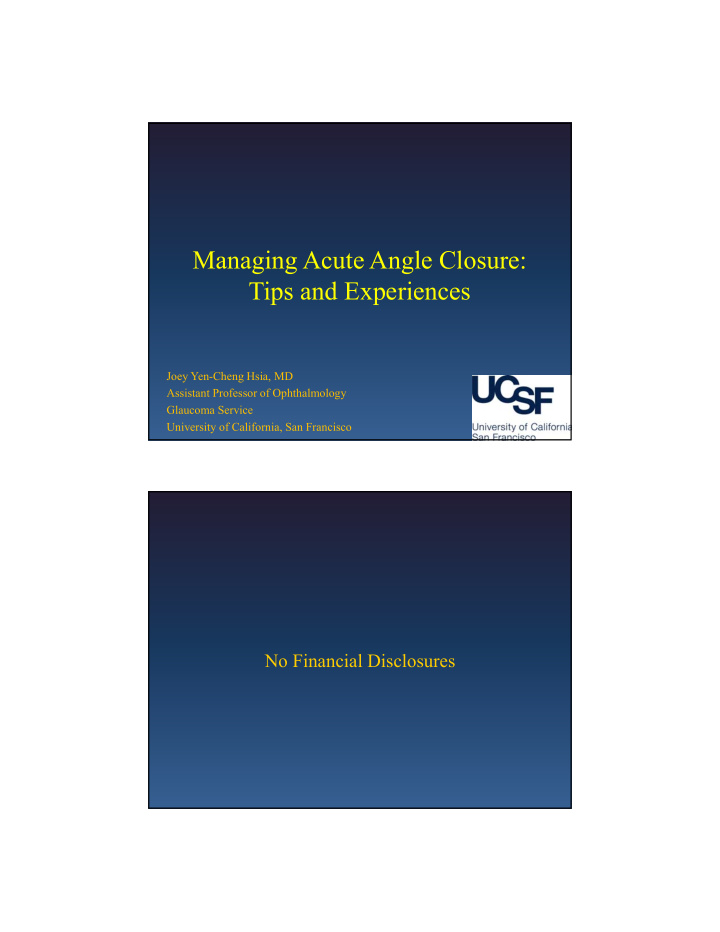



Managing Acute Angle Closure: Tips and Experiences Joey Yen-Cheng Hsia, MD Assistant Professor of Ophthalmology Glaucoma Service University of California, San Francisco No Financial Disclosures
Introduction • Acute elevation of IOP to a very high level due to abrupt closure of TM • Most commonly due to pupillary block • Potential blinding disease requiring rapidly decrease the IOP • Determine the etiology of the attack and treat accordingly Acute Angle Closure • Hyperopia • Corneal edema • Conjunctival • Age injection • Female • Mid-dilated • Inuit or pupil Asian • Segmental Iris ethnicity atrophy • Glaukomflecken • +Family or personal history • Eye pain / headache • Nausea/vomiting • Blurry vision • Halo
Examination • Examination can be difficult: patient in severe pain, nausea/vomiting, edematous cornea – Lower the IOP fast! • Careful slit-lamp examination including gonioscopy of both eyes • Glaucomatous cupping and extensive PAS suggest CACG Determine the Etiology – Acute primary angle closure – Subluxed lens: PXE, ectopia lentis – Plateau / pseudo-plateau iris – Ciliochoroidal effusion – Lens-induced: phacomorphic
Time to Treatment • Li and Han et al . ( Submitted, 2019 ) • Retrospective case series from China, N=1,030 and are predictors for blindness Success of Medical Therapy • Time to treatment correlate with the success of medical therapy alone • Success of medical therapy <50% if treatment is delayed of 24-72 hours • Patients who failed Wong et al. Singapore Med J. 1997 medical therapy are more likely to to develop chronic glaucoma
Acute Medical Therapy • Miotic (Pilocarpine) • Topical aqueous suppressants – Induce miosis – Beta-blocker – Avoid 4% - increase iris – Alpha-adrenergic vascular congestion and – Carbonic anhydrase inhibitor anterior rotation of lens iris diaphragm Carbonic Anhydrate Inhibitor • IV or oral tablet • Methazolamide slower onset • Okay to use in patient with self reported minor sulfonamide antibiotic allergy • Avoid in patient with GFR < 10 Shah et al. Ophthalmol ther. 2018
Mannitol • IV mannitol (1g/kg) – 20% mannitol (20g/100ml) • Osmotic agent - Dehydrate the vitreous • Infuse over at least 30 minutes – Rapid infusion can lead to CHF and pulmonary edema • Avoid in patient with cardiac and renal insufficiency Procedural Intervention – 30 gauge needle on syringe without plunger – Pressure force through 30 gauge needle is about 12 mmHg – Effective in lowering IOP in acute phase – At least 180 degree treatment – Can address non-pupillary block angle closure
Addressing Pupillary Block • Adequate size (~200um) • Sequential argon-yag for thick iris • Effective mid-term IOP control, but not long term • Will not affect clinical AACG outcome of subsequent cataract surgery After LPI Cataract Surgery
LPI vs Phaco Phaco is more effective than LPI in preventing Phaco IOP rise after APAC At 18 months: LPI • LPI: IOP • Phaco: IOP Lam et al. Ophthalmology, 2008. Cataract Surgery in APAC : corneal edema, shallow chamber, poor dilation with floppy iris, large lens, and possible zonulopathy • Abort acute attack medically and with laser, then proceed with phaco • Surgical tips: – preoperative mannitol, high viscosity OVD – Consider iris hooks to avoid iris prolapse
Other Surgical Consideration • Primary trabeculectomy has (>50%) with high rate of postoperative shallow chamber (25%) – Aung et al. Ophthalmology, 2000 • Can consider Phaco+GSL if remains at conclusion of phaco in patients severe glaucomatous cupping Preoperative Postoperative – Teekhasaenee et al. Ophthalmology 1999 – Husain et al. JAMA ophthalmology 2019 Treat the Fellow Eye (>50%) of developing APAC • Avoid dilation, but if needed use tropicamide only • Pilocarpine can be consider if patient refuse intervention • LPI is effective, but up to 25% will still be concludable and 10% will experience IOP elevation • Consider cataract if fellow eye has PAC or early PACG of if there’s visually significant cataract/anisometropia
Take Home Points • AACG is an ocular emergency requiring prompt IOP reduction • Time to treatment is predictive of visual outcome and response to medical therapy • Address the underlying etiology to prevent recurrent attack • LPI is effective for mid-term IOP control but cataract surgery offers long-term control • Treat the fellow eye Thank you Email: Joey.hsia@ucsf.edu FAX: 415-353-4250
Recommend
More recommend